Cerebellar Blood Flow and Gene Expression in Crossed Cerebellar Diaschisis after Transient Middle Cerebral Artery Occlusion in Rats
Abstract
1. Introduction
2. Results
2.1. Baseline Characteristics
2.2. Time Course of CBF and CbBF after MCAO
2.3. Gene Expression Changes in the Cerebellar Cortex Induced by MCAO
2.4. Expression of Oxidative Stress-Related Proteins in the Cerebellar Cortex
2.5. Apoptosis in the Cerebellar Cortex Induced by MCAO
3. Discussion
3.1. Cerebral and Cerebellar Blood Flow Analysis
3.2. Gene Expression in the Cerebellar Cortex
3.3. Study Limitations
4. Materials and Methods
4.1. Ethics Statement
4.2. Animals
4.3. Surgical Procedures
4.4. Neurological Assessment
4.5. Blood Flow Assessment Using SPECT
4.6. cDNA Microarray
4.7. Western Immunoblotting Using Brain Homogenates
4.8. TUNEL Analysis
4.9. Statistical Analysis
5. Conclusions
Author Contributions
Funding
Conflicts of Interest
Abbreviations
| CCD | Crossed cerebellar diaschisis |
| SPECT | Single photon emission computed tomography |
| TTC | 2,3,5-triphenyltetrazolium hydrochloride |
| MCAO | Middle cerebral artery occlusion |
| CBF | Cerebral blood flow |
| CbBF | Cerebellar blood flow |
| ROI | regions of interest |
| GSEA | Gene Set Enrichment Analysis |
| Nrf2 | nuclear factor erythroid 2-related factor 2 |
| HO-1 | heme oxygenase-1 |
| TUNEL | terminal deoxynucleotidyl transferase deoxyuridine triphosphate nick-end labeling |
| ECA | External carotid artery |
| mNSS | modified Neurological Severity Score |
References
- Finger, S.; Koehler, P.J.; Jagella, C. The Monakow concept of diaschisis: Origins and perspectives. Arch. Neurol. 2004, 61, 283–288. [Google Scholar] [CrossRef]
- Baron, J.C.; Bousser, M.G.; Comar, D.; Castaigne, P. “Crossed cerebellar diaschisis” in human supratentorial brain infarction. Trans. Am. Neurol. Assoc. 1981, 105, 459–461. [Google Scholar]
- Carrera, E.; Tononi, G. Diaschisis: Past, present, future. Brain 2014, 137, 2408–2422. [Google Scholar] [CrossRef]
- Gold, L.; Lauritzen, M. Neuronal deactivation explains decreased cerebellar blood flow in response to focal cerebral ischemia or suppressed neocortical function. Proc. Natl. Acad. Sci. USA 2002, 99, 7699–7704. [Google Scholar] [CrossRef]
- Lim, J.S.; Ryu, Y.H.; Kim, B.M.; Lee, J.D. Crossed cerebellar diaschisis due to intracranial hematoma in basal ganglia or thalamus. J. Nucl. Med. 1998, 39, 2044–2047. [Google Scholar]
- Komaba, Y.; Mishina, M.; Utsumi, K.; Katayama, Y.; Kobayashi, S.; Mori, O. Crossed cerebellar diaschisis in patients with cortical infarction: Logistic regression analysis to control for confounding effects. Stroke 2004, 35, 472–476. [Google Scholar] [CrossRef]
- Liu, Y.; Karonen, J.O.; Nuutinen, J.; Vanninen, E.; Kuikka, J.T.; Vanninen, R.L. Crossed cerebellar diaschisis in acute ischemic stroke: A study with serial SPECT and MRI. J. Cereb. Blood Flow Metab. 2007, 27, 1724–1732. [Google Scholar] [CrossRef]
- Forster, A.; Kerl, H.U.; Goerlitz, J.; Wenz, H.; Groden, C. Crossed cerebellar diaschisis in acute isolated thalamic infarction detected by dynamic susceptibility contrast perfusion MRI. PLoS ONE 2014, 9, e88044. [Google Scholar] [CrossRef]
- Sobesky, J.; Thiel, A.; Ghaemi, M.; Hilker, R.H.; Rudolf, J.; Jacobs, A.H.; Herholz, K.; Heiss, W.D. Crossed cerebellar diaschisis in acute human stroke: A PET study of serial changes and response to supratentorial reperfusion. J. Cereb. Blood Flow Metab. 2005, 25, 1685–1691. [Google Scholar] [CrossRef]
- Kim, Y.; Lim, S.H.; Park, G.Y. Crossed cerebellar diaschisis has an adverse effect on functional outcome in the subacute rehabilitation phase of stroke: A case-control study. Arch. Phys. Med. Rehabil. 2019, 100, 1308–1316. [Google Scholar] [CrossRef]
- Oikawa, K.; Ogasawara, K.; Saito, H.; Yoshida, K.; Saura, H.; Sato, Y.; Terasaki, K.; Wada, T.; Kubo, Y. Combined measurement of cerebral and cerebellar blood flow on preoperative brain perfusion SPECT imaging predicts development of new cerebral ischemic events after endarterectomy for symptomatic unilateral cervical carotid stenosis. Clin. Nucl. Med. 2013, 38, 957–961. [Google Scholar] [CrossRef]
- Ogasawara, K.; Kobayashi, M.; Komoribayashi, N.; Fukuda, T.; Inoue, T.; Terasaki, K.; Ogawa, A. Transient crossed cerebellar diaschisis secondary to cerebral hyperperfusion following carotid endarterectomy. Ann. Nucl. Med. 2005, 19, 321–324. [Google Scholar] [CrossRef]
- Machado, A.; Baker, K.B. Upside down crossed cerebellar diaschisis: Proposing chronic stimulation of the dentatothalamocortical pathway for post-stroke motor recovery. Front. Integr. Neurosci. 2012, 6, 20. [Google Scholar] [CrossRef] [PubMed]
- Zhang, L.; Zhao, M.; Sui, R.B. Cerebellar fastigial nucleus electrical stimulation alleviates depressive-like behaviors in post-stroke depression rat model and potential mechanisms. Cell. Physiol. Biochem. 2017, 41, 1403–1412. [Google Scholar] [CrossRef] [PubMed]
- Takuwa, H.; Tajima, Y.; Kokuryo, D.; Matsuura, T.; Kawaguchi, H.; Masamoto, K.; Taniguchi, J.; Ikoma, Y.; Seki, C.; Aoki, I.; et al. Hemodynamic changes during neural deactivation in awake mice: A measurement by laser-Doppler flowmetry in crossed cerebellar diaschisis. Brain Res. 2013, 1537, 350–355. [Google Scholar] [CrossRef] [PubMed]
- Beekman, F.; van der Have, F. The pinhole: Gateway to ultra-high-resolution three-dimensional radionuclide imaging. Eur. J. Nucl. Med. Mol. Imaging 2007, 34, 151–161. [Google Scholar] [CrossRef] [PubMed]
- Ceulemans, A.G.; Hernot, S.; Zgavc, T.; Caveliers, V.; Hachimi-Idrissi, S.; Sarre, S.; Lahoutte, T.; Michotte, Y. Serial semiquantitative imaging of brain damage using micro-SPECT and micro-CT after endothelin-1-induced transient focal cerebral ischemia in rats. J. Nucl. Med. 2011, 52, 1987–1992. [Google Scholar] [CrossRef] [PubMed]
- Garrigue, P.; Giacomino, L.; Bucci, C.; Muzio, V.; Filannino, M.A.; Sabatier, F.; Dignat-George, F.; Pisano, P.; Guillet, B. Single photon emission computed tomography imaging of cerebral blood flow, blood-brain barrier disruption, and apoptosis time course after focal cerebral ischemia in rats. Int. J. Stroke 2016, 11, 117–126. [Google Scholar] [CrossRef]
- Marchal, G.; Young, A.R.; Baron, J.C. Early postischemic hyperperfusion: Pathophysiologic insights from positron emission tomography. J. Cereb. Blood Flow Metab. 1999, 19, 467–482. [Google Scholar] [CrossRef]
- Hung, Y.C.; Chou, Y.S.; Chang, C.H.; Lin, H.W.; Chen, H.Y.; Chen, T.Y.; Tai, S.H.; Lee, E.J. Early reperfusion improves the recovery of contralateral electrophysiological diaschisis following focal cerebral ischemia in rats. Neurol. Res. 2010, 32, 828–834. [Google Scholar] [CrossRef]
- Suzuki, T.; Yamamoto, M. Molecular basis of the Keap1-Nrf2 system. Free Radic. Biol. Med. 2015, 88, 93–100. [Google Scholar] [CrossRef]
- Liu, L.; Locascio, L.M.; Dore, S. Critical Role of Nrf2 in experimental ischemic stroke. Front. Pharm. 2019, 10, 153. [Google Scholar] [CrossRef]
- Sandberg, M.; Patil, J.; D’Angelo, B.; Weber, S.G.; Mallard, C. NRF2-regulation in brain health and disease: Implication of cerebral inflammation. Neuropharmacology 2014, 79, 298–306. [Google Scholar] [CrossRef] [PubMed]
- Song, H.; Lu, Y.; Qu, Z.; Mossine, V.V.; Martin, M.B.; Hou, J.; Cui, J.; Peculis, B.A.; Mawhinney, T.P.; Cheng, J.; et al. Effects of aged garlic extract and FruArg on gene expression and signaling pathways in lipopolysaccharide-activated microglial cells. Sci. Rep. 2016, 6, 35323. [Google Scholar] [CrossRef]
- Ungerer, G.; Cui, J.; Ndam, T.; Bekemeier, M.; Song, H.; Li, R.; Siedhoff, H.R.; Yang, B.; Appenteng, M.K.; Greenlief, C.M.; et al. Harpagophytum procumbens extract ameliorates allodynia and modulates oxidative and antioxidant stress pathways in a rat model of spinal cord injury. Neuromol. Med. 2020, 22, 278–292. [Google Scholar] [CrossRef] [PubMed]
- Li, J.; Che, Y.; Diao, Y.; Hou, S.; Wang, Y. Occlusion of middle cerebral artery induces apoptosis of cerebellar cortex neural cells via caspase-3 in rats. Turk. Neurosurg. 2011, 21, 567–574. [Google Scholar] [CrossRef]
- Chan, H.H.; Cooperrider, J.L.; Park, H.J.; Wathen, C.A.; Gale, J.T.; Baker, K.B.; Machado, A.G. Crossed cerebellar atrophy of the lateral cerebellar nucleus in an endothelin-1-induced, rodent model of ischemic stroke. Front. Aging Neurosci. 2017, 9, 10. [Google Scholar] [CrossRef]
- Stieltjes, B.; Kaufmann, W.E.; van Zijl, P.C.; Fredericksen, K.; Pearlson, G.D.; Solaiyappan, M.; Mori, S. Diffusion tensor imaging and axonal tracking in the human brainstem. NeuroImage 2001, 14, 723–735. [Google Scholar] [CrossRef]
- Kim, J.; Lee, S.K.; Lee, J.D.; Kim, Y.W.; Kim, D.I. Decreased fractional anisotropy of middle cerebellar peduncle in crossed cerebellar diaschisis: Diffusion-tensor imaging-positron-emission tomography correlation study. Am. J. Neuroradiol. 2005, 26, 2224–2228. [Google Scholar]
- Morimoto, J.; Yasuhara, T.; Kameda, M.; Umakoshi, M.; Kin, I.; Kuwahara, K.; Kin, K.; Okazaki, M.; Takeuchi, H.; Sasaki, T.; et al. Electrical stimulation enhances migratory ability of transplanted bone marrow stromal cells in a rodent ischemic stroke model. Cell. Physiol. Biochem. 2018, 46, 57–68. [Google Scholar] [CrossRef]
- Belayev, L.; Alonso, O.F.; Busto, R.; Zhao, W.; Ginsberg, M.D. Middle cerebral artery occlusion in the rat by intraluminal suture. Neurological and pathological evaluation of an improved model. Stroke 1996, 27, 1616–1622. [Google Scholar] [CrossRef]
- Chen, J.; Sanberg, P.R.; Li, Y.; Wang, L.; Lu, M.; Willing, A.E.; Sanchez-Ramos, J.; Chopp, M. Intravenous administration of human umbilical cord blood reduces behavioral deficits after stroke in rats. Stroke 2001, 32, 2682–2688. [Google Scholar] [CrossRef]
- Kin, K.; Yasuhara, T.; Kameda, M.; Tomita, Y.; Umakoshi, M.; Kuwahara, K.; Kin, I.; Kidani, N.; Morimoto, J.; Okazaki, M.; et al. Cell encapsulation enhances antidepressant effect of the mesenchymal stem cells and counteracts depressive-like behavior of treatment-resistant depressed rats. Mol. Psychiatry 2018. [Google Scholar] [CrossRef]
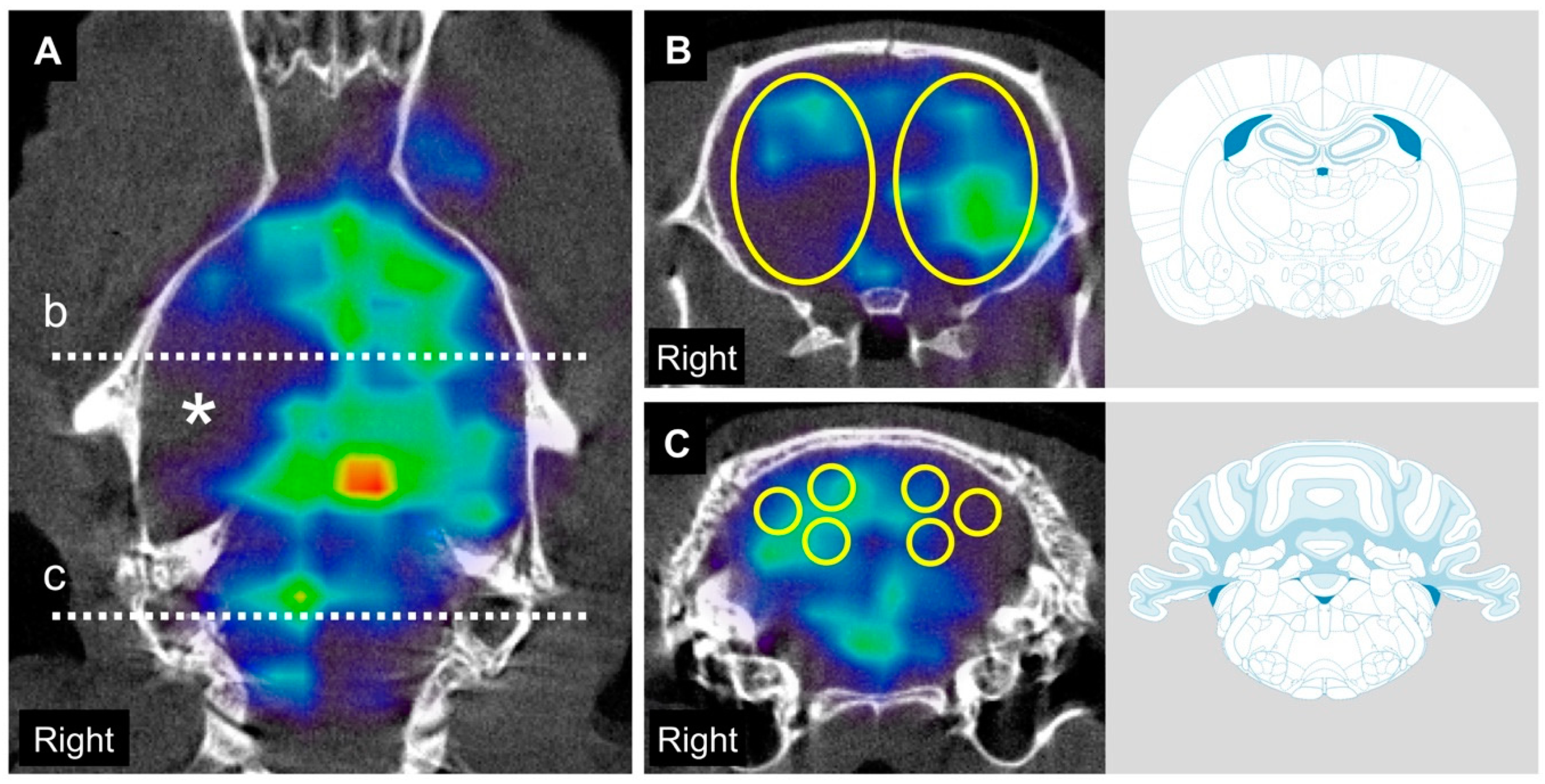
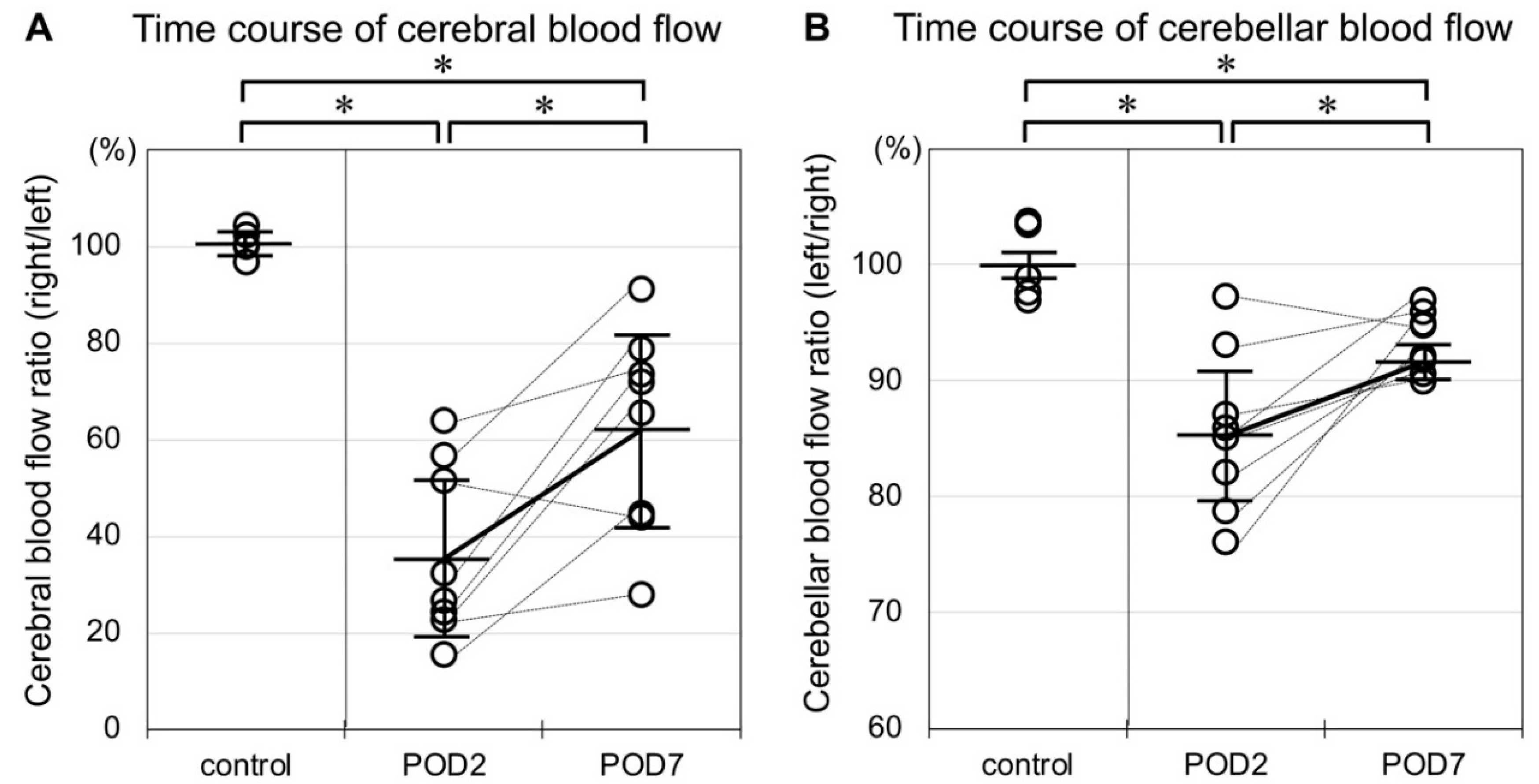
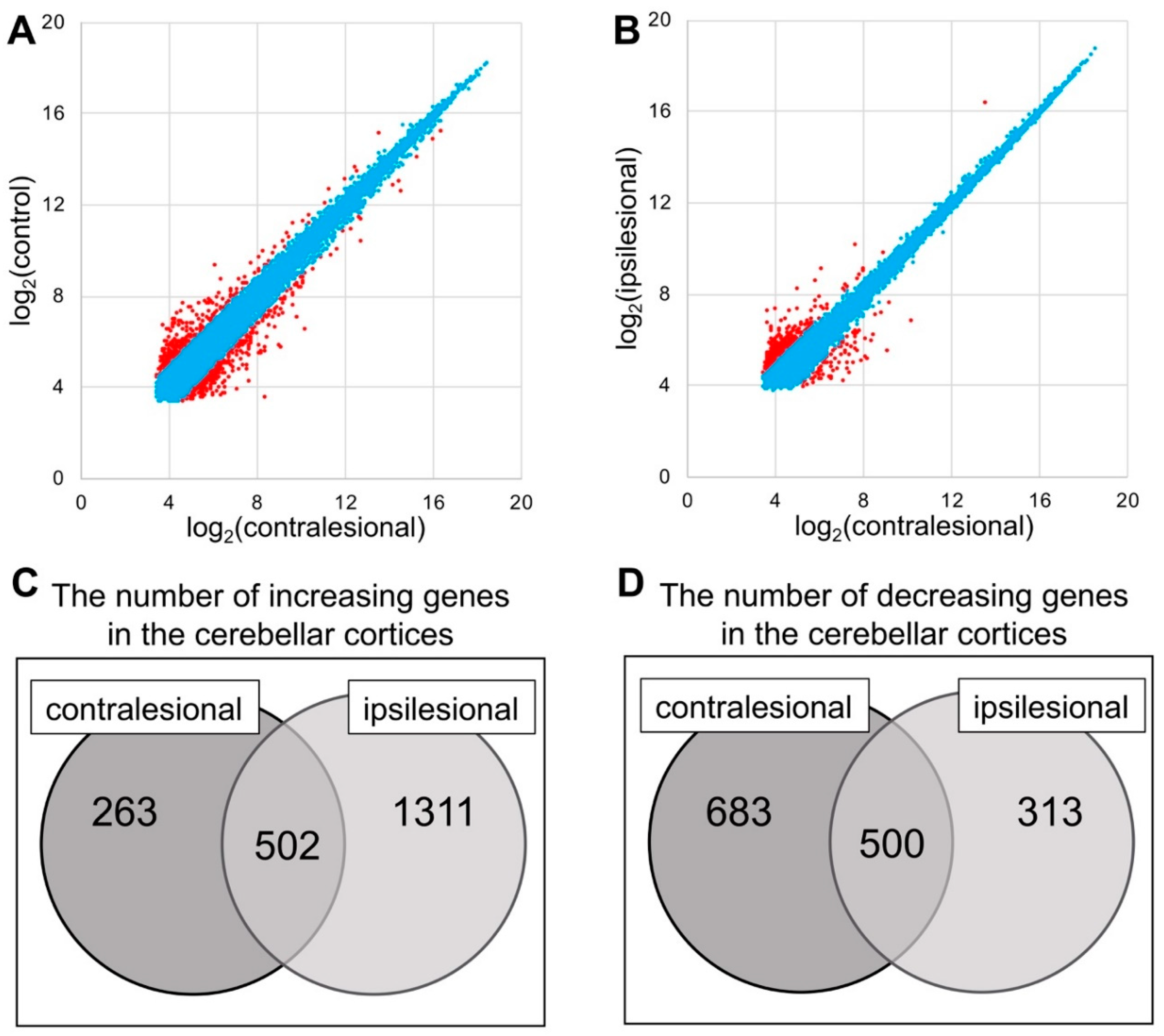
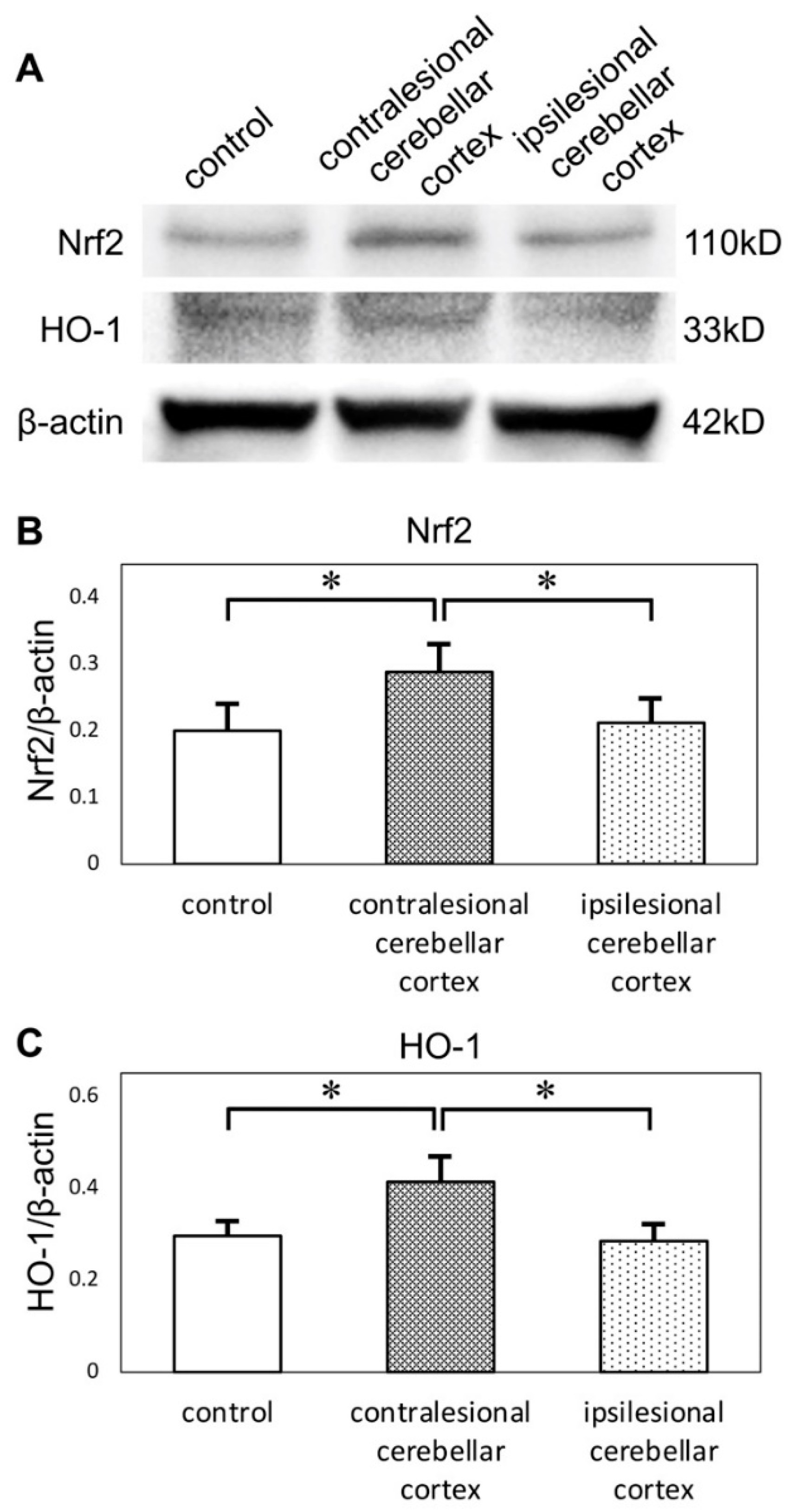
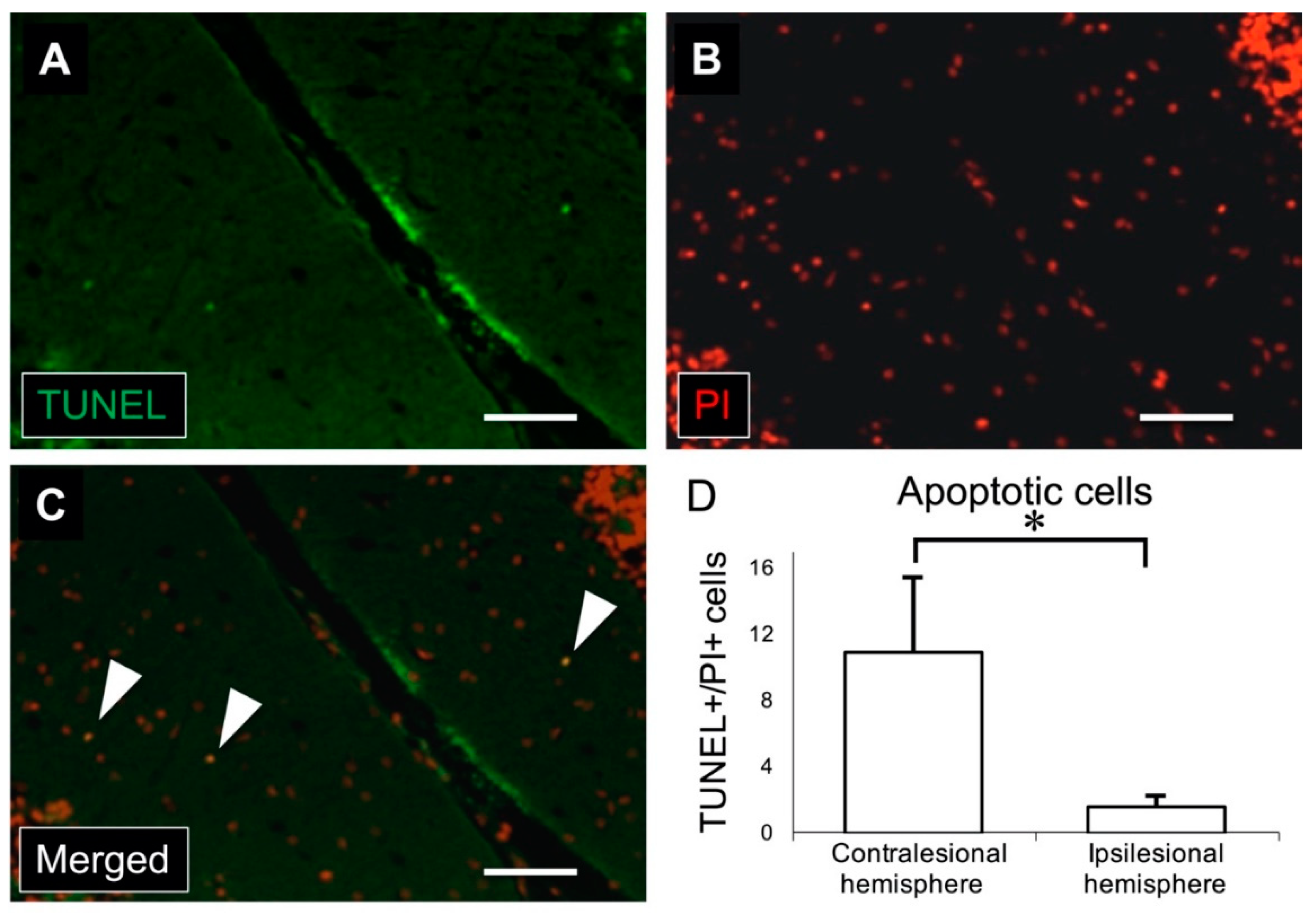
| Gene Sets | NES | Nominal p-Value | FDR q-Value |
|---|---|---|---|
| Apical surface | 1.4829147 | 0.08070175 | 0.41270936 |
| Oxidative phosphorylation | 1.4047105 | 0.03902439 | 0.3811725 |
| Hypoxia | 1.3170835 | 0.056603774 | 0.421758 |
| Apoptosis | 1.2919638 | 0.05142857 | 0.36732572 |
| Reactive oxygen species pathway | 1.1763533 | 0.20440252 | 0.56658465 |
| Fatty acid metabolism | 1.1711965 | 0.1904762 | 0.4835092 |
| IL6 JAK STAT3 signaling | 1.161279 | 0.19491525 | 0.43585464 |
| p53 pathway | 1.1298119 | 0.21857923 | 0.45179152 |
| Interferon-γ response | 0.999022 | 0.4489796 | 0.7390757 |
| TNF-α signaling via NF-κB | 0.93690044 | 0.61290324 | 0.85676676 |
| UV response UP | 0.81916744 | 0.8905473 | 1 |
| Myogenesis | 0.79656494 | 0.9 | 1 |
| Spermatogenesis | 0.7820479 | 0.85542166 | 1 |
| Glycolysis | 0.76751935 | 0.90338165 | 0.95213044 |
| DNA repair | 0.65829355 | 0.97890294 | 0.97356385 |
| Gene Sets | NES | Nominal p-Value | FDR q-Value |
|---|---|---|---|
| Angiogenesis | −1.3574327 | 0.08066759 | 1 |
| Apical junction | −1.3069164 | 0.0870098 | 1 |
| Bile acid metabolism | −1.2624685 | 0.1498029 | 1 |
| G2M checkpoint | −1.2126812 | 0.19066148 | 1 |
| KRAS signaling DN | −1.1927822 | 0.1927555 | 1 |
| Xenobiotic metabolism | −1.1860862 | 0.18062201 | 1 |
| Myc targets v1 | −1.1843342 | 0.23136246 | 0.89537966 |
| UV response DN | −1.1636689 | 0.21843435 | 0.87870497 |
| coagulation | −1.153253 | 0.26289308 | 0.8315621 |
| Heme metabolism | −1.1413887 | 0.27120823 | 0.79227114 |
| Estrogen response early | −1.1271846 | 0.25159642 | 0.7696532 |
| Mitotic spindle | −1.1119729 | 0.31737345 | 0.7581073 |
| Androgen response | −1.0270199 | 0.44093406 | 0.9964891 |
| KRAS signaling UP | −0.98356724 | 0.5177665 | 1 |
| Allograft rejection | −0.95813197 | 0.57441574 | 1 |
| E2f targets | −0.94351673 | 0.5536424 | 1 |
| Cholesterol homeostasis | −0.9269579 | 0.58760107 | 1 |
| Peroxisome | −0.8992629 | 0.6364847 | 1 |
| Epithelial mesenchymal transition | −0.88842046 | 0.6766467 | 1 |
| IL2 STAT5 signaling | −0.87723947 | 0.6804878 | 1 |
| TGF β signaling | −0.8657552 | 0.67280453 | 1 |
| Inflammatory response | −0.8562549 | 0.7315036 | 0.9768945 |
| Adipogenesis | −0.83410215 | 0.78725964 | 0.98129094 |
| Complement | −0.7720234 | 0.86107785 | 1 |
| Estrogen response late | −0.7568291 | 0.88578373 | 1 |
| Interferon α response | −0.73042226 | 0.83664775 | 1 |
| PI3K AKT mTOR signaling | −0.6855016 | 0.92736703 | 1 |
| mTORC1 signaling | −0.644657 | 0.9788294 | 1 |
| Protein secretion | −0.59601074 | 0.9776021 | 1 |
| Unfolded protein response | −0.457154 | 1 | 0.99926555 |
© 2020 by the authors. Licensee MDPI, Basel, Switzerland. This article is an open access article distributed under the terms and conditions of the Creative Commons Attribution (CC BY) license (http://creativecommons.org/licenses/by/4.0/).
Share and Cite
Kidani, N.; Hishikawa, T.; Hiramatsu, M.; Nishihiro, S.; Kin, K.; Takahashi, Y.; Murai, S.; Sugiu, K.; Yasuhara, T.; Miyazaki, I.; et al. Cerebellar Blood Flow and Gene Expression in Crossed Cerebellar Diaschisis after Transient Middle Cerebral Artery Occlusion in Rats. Int. J. Mol. Sci. 2020, 21, 4137. https://doi.org/10.3390/ijms21114137
Kidani N, Hishikawa T, Hiramatsu M, Nishihiro S, Kin K, Takahashi Y, Murai S, Sugiu K, Yasuhara T, Miyazaki I, et al. Cerebellar Blood Flow and Gene Expression in Crossed Cerebellar Diaschisis after Transient Middle Cerebral Artery Occlusion in Rats. International Journal of Molecular Sciences. 2020; 21(11):4137. https://doi.org/10.3390/ijms21114137
Chicago/Turabian StyleKidani, Naoya, Tomohito Hishikawa, Masafumi Hiramatsu, Shingo Nishihiro, Kyohei Kin, Yu Takahashi, Satoshi Murai, Kenji Sugiu, Takao Yasuhara, Ikuko Miyazaki, and et al. 2020. "Cerebellar Blood Flow and Gene Expression in Crossed Cerebellar Diaschisis after Transient Middle Cerebral Artery Occlusion in Rats" International Journal of Molecular Sciences 21, no. 11: 4137. https://doi.org/10.3390/ijms21114137
APA StyleKidani, N., Hishikawa, T., Hiramatsu, M., Nishihiro, S., Kin, K., Takahashi, Y., Murai, S., Sugiu, K., Yasuhara, T., Miyazaki, I., Asanuma, M., & Date, I. (2020). Cerebellar Blood Flow and Gene Expression in Crossed Cerebellar Diaschisis after Transient Middle Cerebral Artery Occlusion in Rats. International Journal of Molecular Sciences, 21(11), 4137. https://doi.org/10.3390/ijms21114137






